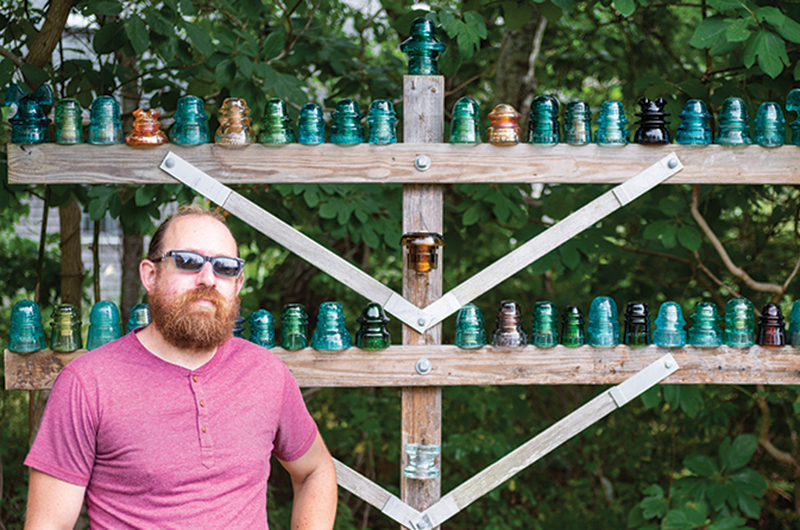After a career in newspapering, I confess to collecting anything about journalism: a N.Y. Daily News yo-yo, newsboy statues, a reporter whirligig, a Clark Kent/Superman cookie jar, newspaper pins (“Bless the Press”), a 1916 foreign correspondent’s folding portable typewriter, a comic-strip umbrella, and Linotype slugs. Ordinary stuff, at least for a newspaperman. The collecting bug struck early. As a boy, I collected rocks, stamps, coins, toy cars, and baseball cards.
So, I’m delighted to discover that Vineyarders, like an estimated one in three Americans, collect not only fine art but ordinary stuff too: used tennis rackets (Tony Omer), wood with holes (Pia Gundersen), old water sprinklers (Pam Schillig Coblyn), yardsticks (Jenifer Strachan), key chains (Dolores Borza), soda bottles (Eddie Pacheco), and skunk furs (John Thibodeau).
Why do Vineyarders collect? Nis Kildegaard, seventy, an Edgartown collector of typewriters, waffle irons, staplers, and dice cups, offers four explanations: a personal connection through work (Kildegaard used staplers and typewriters as a Vineyard Gazette editor for twenty-four years and an Edgartown Public Library reference librarian for fourteen years). He also cites the opportunity to learn the objects’ history, enjoy the beauty of their design, and experience “the joy of the hunt.” In retirement, Kildegaard, who loves to tinker, has turned a hobby into a business. He searches eBay for old typewriters, buying them for as little as $20 to $30, repairing and refurbishing them, then selling them for as much as $500. Some special typewriters, he admits, “it takes me a few months before I’m willing to sell.”
I’m especially interested in Vineyarders who collect objects that help tell the Island’s history and remind us of the words of the late West Tisbury historian David McCullough: “History is who we are and why we are the way we are.” George Fisher, sixty-five, formerly a sergeant in the Oak Bluffs police department, collects ship models made by Charles Van Riper’s Vineyard Haven shop between 1933 and 1962. Descended from three generations of seagoers – boat yard operator, lighthouse keeper, and fisherman – Fisher recalls as a child running the Van Ryper models (spelled with a y to ensure proper pronunciation) across the carpet “until they were destroyed.” Today his collection of 140 models includes the Vineyard side-wheel steamer Uncatena (1902–1930); the Vineyard ferry Naushon (launched in 1929), which served as a hospital ship and troop carrier at the Normandy invasion in World War II; and other classic Van Ryper models purchased from around the globe. Fisher says he likes “bringing these ships back to their home port.”
Doug Ulwick, sixty-eight, an Oak Bluffs architect, musician (keyboards, concert harp, folk guitar), and historian, insists he is not an expert, just a collector of what appeals to him, things often plucked from the shelves of the Chicken Alley thrift shop in Vineyard Haven. While nineteenth-century 3D stereoscopic photographs of Oak Bluffs and an early concert grand piano from the Tabernacle are prized parts of his collection, he focuses on kerosene lamps and even earlier whale oil lamps (“people don’t know what they are”). The dozens of functioning lamps complement his fourteen-by-forty-foot house, built in the nineteenth-century Camp Meeting style: “I use the lamps for illumination.” He points to a tall Aladdin lamp that produces a white light, four times more light per gallon of kerosene than equivalent wick lamps. Why do people collect, I ask? Ulwick says, “They need joy.”
The collections of hotelier Sherm Goldstein and power-company lineman Nick LaBell appeal to me because they highlight the beauty in plain, practical objects. Goldstein, seventy-five, has collected more than a thousand eel gigs – multi-pronged mini-pitchforks – over the past forty years. A wall display in his West Tisbury home features gigs from Belgium, France, Holland, and Italy, as well as favorites from the United States: a tiny one with three small prongs that he imagines a grandfather made for his grandchild and one that includes at its center, between its two utilitarian prongs, a delicate heart of metal. A fifty-one-pound striped bass mounted on a nearby wall demonstrates why he collects eel gigs: “The interface between eels and striped bass fascinates me.” He uses eels as bait to catch his favorite fish. And he likes nature’s symmetry of opposites: striped bass live in the ocean and visit brackish and fresh water to breed, while eels live in brackish and fresh water and breed in the ocean.
LaBell, forty, collects Bakelite, ceramic, and, more commonly, glass insulators that eventually were replaced by rubber ones. (“People were shooting [the glass ones] down,” he says.) The insulators, now displayed inside and in the front yard of his West Tisbury home, were used on the poles that carried the signals for telephones and telegrams. LaBell’s collection includes insulators of all sizes (a few ounces to forty-five pounds), all shapes (Mickey Mouse ears, beehive, fire plug, pony, tree cutter), and colors. His stunning blue glass insulators, for example, come in such shades as cobalt, electric, peacock, and sapphire. LaBell finds insulators around the Vineyard and on eBay. Some rare insulators sell for $5,000, but LaBell pursues beauty and variety. If he acquires a rare insulator, “I end up selling it, because I feel guilty.”
Some people, as do I, collect stories and memories. Sandra Lippens, eighty-two, proprietor of Tilton Tents and Party Rentals for forty years, writes on toolshed doors in black marker about memorable people and moments. For example: “An M.V. employee was told to go pick up jack – so he came to Tilton’s and rented two eight-ton jacks, while ‘Jack’ waited at the boat to be picked up! True story!”
Maybe my next column should be about nonhuman Vineyarders who collect. Nathaniel Wade tells me his dog collects ticks. Of course, plenty of humans on the Vineyard have been known to collect those too.





